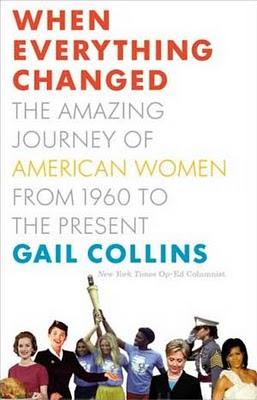When Everything Changed: The Amazing Journey of American Women from 1960 to the Present

Oh, Gail Collins, you had me at New York Times columnist. Maybe it’s because I’ve lived away from New York for so long now and have to read it online most of the year, but holding printed and bound words from a witty Times writer in a book that I can dip into for a few minutes, or a hour, whenever I like is brainy self-indulgence that I can say yes to.
My mother grew up in the ‘50s and ‘60s, and I’ve always had a thing for vintage and retro pop culture. If this is you, too, you’ll quickly find yourself on board as well, Times fetish or no. The ‘New Yorkness’ of Collins’ writing style is so readable that the broad range of subjects covered in its 405 pages are cohesive and coherent. As for the title of the book, it had me thinking immediately—I had a mini-epiphany before even cracking the cover—of course, then it all changed.
When Everything Changed contains facts I should have known, such as the shock-value of women wearing trousers, archaic divorce laws with state-by-state variations that virtually trapped women in marriage, and the ‘speed-dating’ approach many women took to college in the '60s, using higher learning as a way to find a husband. The chronicles pivotal moments in our recent feminist history—from things that seem simple, like adhesive maxi pads, to nation-altering events, like the Equal Rights Amendment.
Readers of all ages will enjoy finding their decade in the chronology. The conclusions Collins draws about each era are deft, trustworthy and cogent. It is interesting to see Collins assert that that we are a part of living history, and that these changes, while feeling slow, have been swift in the grand scheme of things. This book is hard to stop reading even if you meant to leave some for later. It flows so well and is written in such a conversational style that I found it easy to carry on for a few more chapters.
The picture section seemed unnecessary to me. I wanted big, iconic illustrations throughout, or none at all, but that’s a small criticism for a largely excellent read. This book is a primer, of sorts, but I felt that the way the images were presented was more cursory than inspiring. The words alone are enough to encourage readers to find out more. Should gender studies, or women’s history be offered as a high school module or elective, I’d recommend this book, or extracts from it as an introductory text.
Based on my enjoyment of When Everything Changed, I’m also interested in tracking down Collins’ precursor to this book: America's Women: 400 Years of Dolls, Drudges, Helpmates, and Heroines. This is a more mainstream feminist text than I’ve read in a while, and I was almost put off by the schmaltzy tone of the book jacket, which I interpreted as lauding Hilary Clinton’s presidential campaign as a symbol for the be all and end all of women’s equality. This tone continues in the final chapter itself, which I found to be a dissatisfying gloss over of the achievements of all American women, rather than just the privileged few in mainstream politics. Moreover, the stylistically vague 'gloss' of American women can be interpreted as a very real slight, considering the minimal representation of women not from the U.S.
Most interesting to me is the epilogue section. While some of it is depressing, the fates of some of the figures mentioned in the book are quite uplifting. There’s even a witty bit about Barbie dolls. Overall, the book is enjoyable and informative. It serves as an inspiring reminder of not only when it all changed, but how it all changed.
Oh, do I ever love Gail. Excellent review!